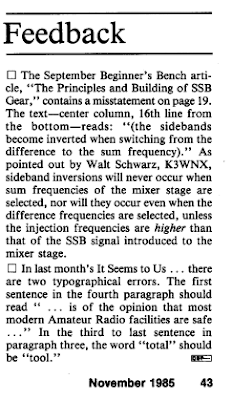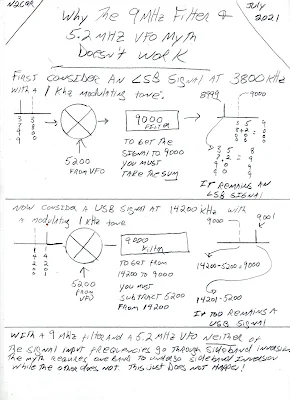Rob Sherwood NC0B is one of the real authorities on receiver performance. Many of us have relied on his ratings of commercial receivers for many years. His recent presentation to the Madison DX Club has a lot of really interesting information. There is also, I think, some stuff that homebrewers will find distressing.
Just some things that I noticed:
-- Rob mentioned a move back to 9 MHz IF filters and a move away from dual-conversion rigs with a high IF. He also mentioned the combination of a 9 MHz IF and a 5 MHz VFO as a way of easily getting on both 75 and 20 meters.
-- Rob discussed phase noise from synthesizers, a topic we discussed at length (some would say ad nauseum!) a year or so ago.
-- Rob really praised the "Pure Signal" system of one of the SDR manufacturers. He showed the completely rectangular waterfall display of a Pure Signal transmitter. I'm afraid that simple crystal rigs might never live up to this standard. An embrace of this high standard could discourage the construction of simpler, HDR rigs. We should not let the perfect be the enemy of the good!
-- We often hear SSB ops complaining that some other SSB op is "splattering all over the band." It often turns out that what is really happening is that a clean SSB signal is just overloading the receiver of an operator who does not know how to turn off his pre-amp or turn on an attenuator. Rob shows us how to really know if the problem is in fact at the other end: He looks at key clicks from two different CW signals on 160 meters. Both are at roughly the same level in his receiver But one is clicking all over the place while the other is not. With this kind of comparative info, we can be sure that the problem is the transmitting station's fault.
-- In discussing when to turn on the pre-amp (or the attenuator) Rob revives the old practice of just listening to the band noise. If you can hear the band noise when you switch from dummy load to receive antenna, you have enough RF gain. Adding more will only make things worse.
-- There was an interesting question about how to evaluate the performance of receivers when there are many signals inside the receiver's passband. This is the case with FT-8. Rob said this situation needs more research.
I don't mean to be critical here -- Rob is the guy who evaluated commercial rigs. And he is a contester. So his presentation is, of necessity, going to have a very "appliance operator" orientation. There seems to be an assumption that the only "rigs" that modern hams can use are commercial products. At one point Rob admits that most hams just can't repair these rigs. There is much for homebrewers to learn from experts like Rob, but presentations like this also remind us of what a tiny minority we really are, and how most hams have moved completely away from the old ham tradition of building our own rigs.
Thanks to Rob Sherwood and the Madison DX Club. And thanks to EI7GL for alerting us to this important presentation.










































